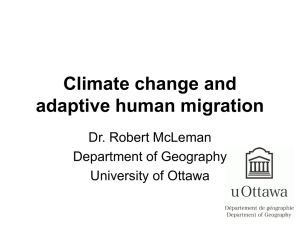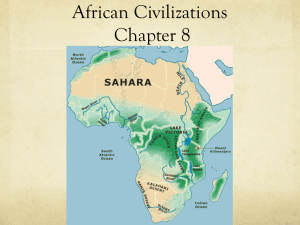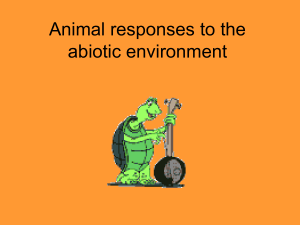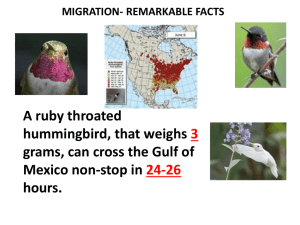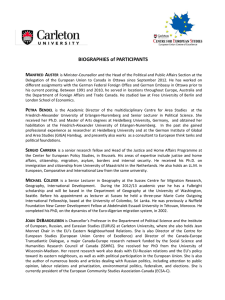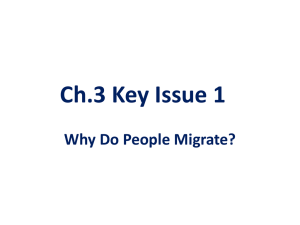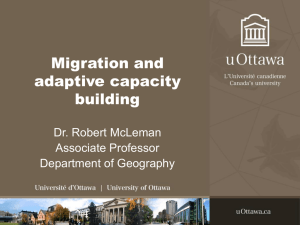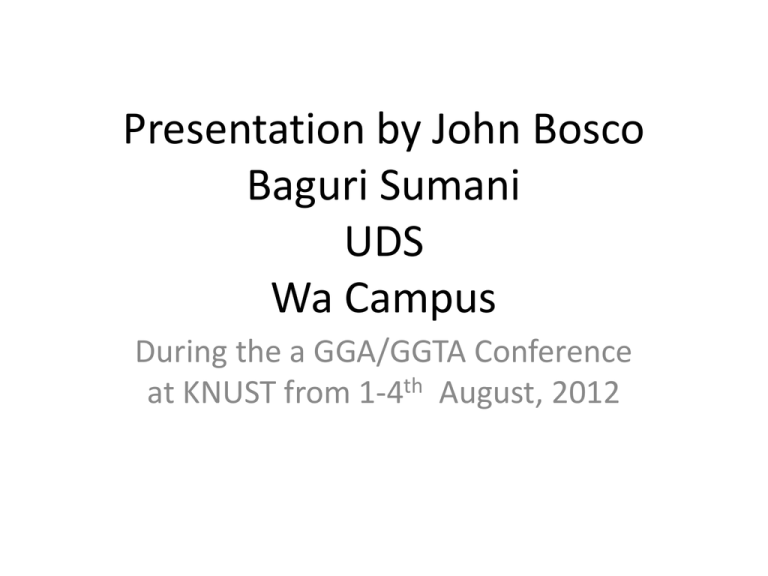
Presentation by John Bosco
Baguri Sumani
UDS
Wa Campus
During the a GGA/GGTA Conference
at KNUST from 1-4th August, 2012
Presentation Outline
Introduction
Brief Literature Review
Problem statement
Study objectives
Study area and methodology
Results
Conclusion and Recommendations
References
Introduction
Successive gov’ts have initiated policies,
programs, plans and initiatives to manage
out-migration since independence
Literature surveyed revealed that outmigration has been increasing in the Upper
West Region
Factors accounting for migration is a subject of
debate (Suhrke, 1993, Akokpari, 1998; PerchNielson, 2004; Mcleman and Smit, 2006)
Brief Literature survey
• Migration as a developmental challenge (Davidson et al
(2003 and Mcleman and Smit, 2006)
• No agreement on causes of migration (suhrke, 1993 ;
Akokpari, 1998 and Perch-Nielson, 2004)
• Neo-classical views dominate (Massey, 1993)
• Environmental degradation is often mentioned as
physical factors (Suhrke, 1993; Bilsboro, 1991)
• Climate is hardly mentioned or only mentioned
tangentially (Perch-Nielsen, 2004)
• Hence the design of this
Problem statement
Nadowli District has been experiencing outmigration since its creations
Reasons for migration:
Economic
Socio- cultural
Population pressure
Conflicts/wars
Environmental conditions hardly mentioned
Environment-migration relations at the general
level without disaggregating the various factors
• However, climatic variables are indispensable
resources for agric productivity and
production
Climate variability/change has been blame
elsewhere for migration (Adelekan and
Afolayan, 1999; Magadza,2000; MezeHausken, 2000 and Mcleman and Smit,2006)
• Hence, this study was designed to determine
the influence of climate variability on human
migration
Study objectives
• Main objective
i. To find out the influence of climate
variability on human migration in Nadowli
District
• Specific objectives:
i. Climatic (key variables) trends over the years
ii. Causes of migration
iii The relationships between climatic trends and
migration
iv The relationship between migration and sex
v The relationship between migration and age,
and finally
vi The socio-economic effects of out-migration
on the source region
Study Approach and Methodology
• The study area is Nadowli District
• Data sources
i. Primary
ii. Secondary
• Sampling techniques
Non-Probability
i. Purposive ( GMA and Returned migrants)
• Probability sampling
i. Cluster sampling (3 clusters)
ii. Western- Sankana & Charikpong; CentralDuong & Daffiamah and Eastern- Naro & Fian
iii. Systematic sampling (25hh in each c’ty)- sample
size of 150
• Data collection instruments:
i. Questionnaire administration
ii. Face –to- interviews
iii. FGD
Conceptual Framework
• Climate and migration variables are difficult
to bring under 1 framework (Perch-Nielson
,2004 and Mcleman and Smit, 2006)
• This study modified Mcleman and Smit (2006)
model with ideas from Meze-Hausken (2000)
and Perch-Nielson (2004)
• According to Mcleman and Smit,
V=f(Eslit +ACslit)
Conceptual framework in response to climate
variability
Causes of migration
Economic
Socio-cultural
Modified C’ties:
.Previous members
Return migrants
Environmental
Population
Climate variability
Conflict/wars
Climatic conditions
Agric performance
No, Out-migration
Perceived
favourable
destination
Hsehold decision
Can cope?
Seasonal
Yes, no migration
Permanent
Results
MAMT 5 ry moving average
35.00
34.50
34.00
33.50
MAMT 5 ry moving average
Linear (MAMT 5 ry moving average)
33.00
32.50
32.00
Period in years
Community Description of
Temperature
Temperature
Pre-2000
Post-2000
Description Frequency (%)
Frequency
Future
(%)
Frequency
Percentage
cool
130
87
0
0
0
0
warm
18
12
150
100
99
66
2
1
0
0
51
34
150
100
150
100
150
100
Don't know
Total
Source: Field notes. 2011
Rain Days
120
100
80
Rain Days
60
Series1
Linear (Series1)
40
20
0
Years
Community description of rainfall
Table 4.11: Community description of rainfall
Rainfall
Pre-2000 period
Post-2000 period
Description
Frequency
Percent (%)
Frequency
Percentage (%)
Adequate
139
97
2
1
Inadequate
11
3
148
99
Don't know
0
0
0
0
Total
150
100
150
100
Source: Field notes, 2011
Causes of migration
30
27
25
25
20
17
16
%
15
15
Series1
10
5
0
Climate variability
Conflicts/wars
Economic
Land degradation
Socio-cultural
Destination of migrants
10
7
51
102
36
Upper West Region
Northern Region
Brong Ahofo Region
Ashanti Region
Eastern Region
Outside Ghana
161
Duration of migrants?
300
247
250
200
156
1991-2000
150
2001-2010
120
100
50
50
24
0
0
0
0
0
0
No migration
1-12 months
> 12 months
I don't know
Sex of migrants
285
300
250
200
167
1991-2000
150
2001 2010
100
82
63
50
0
0
0
Migrant sex
Male
Female
Socio-economic effect of migration
Consequence
Beneficial
Negative
Neutral
Total
Frequency
Percentage (%)
131
87
9
6
10
7
150
100
Conclusion
• Over 90% of the people of the study area are
peasant farmers and therefore climatedependent
• Climate variability is the major cause of outmigration in the Nadowli District
• Out-migration is the last resort
• There is an inverse relationship between MAR
and MAT
• Climate- induced migration is affects men
decision to migrate than women
• There is an emerging pattern and trend of
migration (destination and duration)
• Out-migration is generally beneficial with
minor negative consequences
Recommedations
1. Vigorous public education on adaptation and
mitigation strategies
2. Construction of irrigation dams/dug outs
3. Provision of improved seeds and crop
varieties
4. Provision of micro-credits to peasant farmers,
especially women
5. Cultivation of non-traditional crops and
livestock rearing
6. Improved climate prediction and weather
forecasting
7. Formulation and implementation of migration
policy
References
• Abdul-Korah, G.B. (2007). ‘Where is not
home?’: Dagaaba migrants in the Brong Ahafo
Region, 1980 to the present. African Affairs,
106, 71-94.
• Adelekan, I. O. & Afolayan, A. (1999). The role
of climatic variations on migration and human
health in Africa. The Environmentalist, 18(4),
213-218.
• Adiku, S. G. K., Dayananda, P. W. A., Rose, C.
W. & Dowuona, G. N. N. (1997). An analysis of
the within-season rainfall characteristics and
simulation of the daily rainfall in two savanna
zones in Ghana. Agricultural and Forest
Meteorology, 86, 51-62.
• Akokpari, J. K., (1998). The State, refugees
and migration in Sub-Saharan Africa.
International migration, 36, 211-234.
• McLeman, R. and Smit, B. (2006). Migration as
an adaptation to climate change. Climatic
Change, 76, 31-53.
• Nabila, J.S. (1974). The migration of the Frafra
of northern Ghana: A case study of cyclical
labor migration in West Africa .Unpublished
doctoral dissertation, Michigan State
University, East Lansing.


